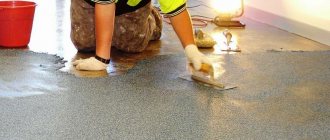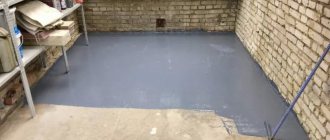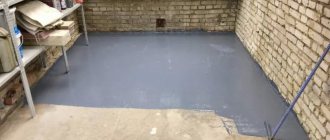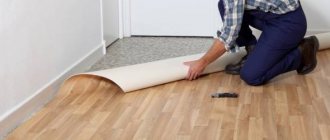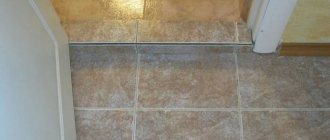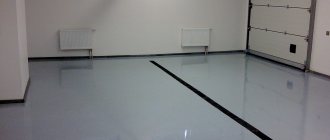Concrete flooring means high strength, reliability and long-term operation. But this building structure has one serious drawback - dust formation. Therefore, we will figure out how to properly remove dust from a concrete floor, what materials and technologies are used for this.
How to remove dust from a concrete floor Source yandex.net
Why is dust removal necessary?
Dust on a concrete base is caused by erosion of the material. First, the upper layers are subjected to this process, then the lower ones, and then not far from the destruction of the structure itself. In addition, concrete dust itself is harmful to humans. It causes diseases such as allergies, asthma and others similar to them.
But that's not all. Strong dust clogs the equipment, causing rapid abrasion of rotating parts and assemblies. The floor itself loses its original appearance due to dust, making the room less attractive in terms of aesthetics. Here you can add constant and frequent cleaning, and not only of the floor base, but of ceiling and wall surfaces. That is, concrete dust is a big problem. Therefore, dust removal from concrete is a necessary process, regardless of whether such a floor is the main base in the room or is a surface for further cladding.
Concrete dust is very harmful Source userapi.com
Materials and technologies
In fact, the dust removal process affects the top layer of the concrete floor. The main task here is to strengthen this layer or cover it with compounds that would be strong and wear-resistant. That is, they could withstand serious loads on them for a long time.
But before carrying out the process itself, it is necessary to prepare the concrete floor.
- The surface is polished using a concrete grinding machine with diamond discs. The device itself is equipped with a dust extractor and a collector for dust and dirt.
- Any, even the newest concrete floor, has defects that need to be covered. For this purpose, special polymer compositions are used today. One of the most popular is epoxy resin with quartz fine-grained sand.
- The concrete base is primed. Optimally - deep penetration primers that bind concrete particles together, thereby strengthening its top layer.
Now about the materials. There are several formulations that are used today. These are the so-called fluates, various impregnations and paints.
Impregnations for concrete bases Source prom.st
Fluats
It should be noted that these substances are not essential for protection. This is an auxiliary material that is applied before painting the concrete floor. But it performs its purpose, namely dust removal, efficiently.
Fluate is a substance of inorganic origin. Essentially, it is a glassy substance, namely silicon dioxide. When applied to the surface of concrete, this material covers it with a durable film with low abrasion. At the same time, the film is not susceptible to the negative effects of chemicals. This is especially true in garages, where technical oils, gasoline and household chemicals on the floor are common.
How to use fluates correctly:
- This is a dry mixture that is diluted in water strictly according to the instructions, taking into account the proportions;
- consumption of finished material – 20 ml per 1 m² of treated area;
- spread it over the floor with rubber scrapers, do it evenly without forming puddles;
- rubbing is carried out until the composition is absorbed into the concrete base.
If everything is done correctly, the dust removal material will dry within 20 minutes. But according to the recommendations of the manufacturers, the floor cannot be treated with anything additional for 24 hours.
Fluates for removing dust from concrete floors Source trelleborg.com
Impregnations
Such materials are often called wetting agents. These are organic compounds based on polymer resins: acrylic, polyurethane or epoxy. The principle of operation of impregnations is based on the penetration of their molecular chains into the pores, channels and cracks of the concrete layer. This is how the latter are filled, connecting the concrete particles together.
Today, manufacturers offer several types of wetting agents:
- Protexil . This impregnation penetrates the concrete quite deeply - 0.5 cm. In fact, it is a crystalline material that fills the pores. It not only removes dust from the surface, but also hardens it. In addition, the resulting film is not afraid of chemicals, even the most aggressive ones.
Protexil - impregnation for concrete Source stroyportal.ru
See also: Catalog of companies that specialize in finishing and paintwork materials and related work
- If the concrete floor is subject to light loads, then acrylic impregnations . Experts consider this material temporary because it has a short service life.
- Epoxy wetting agent does not contain solvents. Therefore, it is recommended to be used where the use of solvent compounds and materials is not allowed.
- Polyurethane is considered universal. This composition penetrates to a depth of 0.3 cm. At the same time, it not only strengthens the layer, but also makes it moisture-resistant and sealed, not to mention chemicals. The most important thing is that polyurethane wetting agents can be used even at sub-zero temperatures.
Let us add that impregnations are often used to treat ceilings and walls. Today you can buy wetting agents on the market that can be used to give the floor a color design. After their application, the concrete base becomes similar to a floor that has been treated with varnish.
Concrete floors with a varnished effect Source savastroy.ru
Topping
Let's look further into the topic of how to treat a concrete floor to avoid dust, and move on to unique compositions, which among experts are called toppings. These are strengthening solutions based on cement and several additives. This material is available in different types on the market, so they are selected taking into account the load on the floor and the category of the room.
In fact, these are the same wetting materials that bind concrete grains into a monolith, which increases the strength and wear resistance of the concrete floor. After applying the topping, a durable film with moisture-repellent and anti-slip properties is formed on the treated surface.
Typically this material is used in high traffic areas. It is applied to a 1 cm thick surface of the floor base that has not yet dried. After which the laid layer is rubbed down. Usually the wetting agent is laid in several layers.
Concrete floor covered with toppings Source eyecorrector.ru
Other dust removal options
There are many materials that can be used to strengthen the top layer. Here are several options for how to remove dust from a concrete floor:
- Liquid glass . To do this, the floors must first be moistened. Apply liquid glass evenly with a regular paint roller. After drying, the surface can be primed and painted. Craftsmen often use a mixture of liquid glass and cement. This composition is more durable.
- Tile adhesive . It is better to use the composition on which granite is laid. The mixture is applied to the surface with a thickness of 0.5 cm.
- A mixture of cement and PVA glue in a ratio of 2:1 . This composition can be used to seal cracks in the floor. The material itself is applied in a layer of 0.5 cm.
- Bitumen varnish , which must be diluted with any solvent. This coating is best applied in three layers. In this case, the previous layer should dry well.
- The most famous method of dust removal is ironing . This is the application of cement to the wet surface of a concrete floor with thorough rubbing of the first using trowels. Usually this process is carried out on the second day after pouring the concrete screed.
- Primer for dust removal . This liquid is sold in plastic containers. It is applied in two layers and bonds the top concrete layer well, penetrating 0.5 cm into it.
What reasons lead to dust formation?
During the operation of a concrete floor covering, its top layer takes on various loads, chemical and mechanical influences, because of this, the destruction of concrete begins, resulting in the formation of cement dust.
- violation of concrete pouring technology.
- improperly prepared mixture.
- adding poor quality components to the solution.
Even if concrete has high strength properties, without proper processing and the use of reinforcing compounds it will be subject to the negative effects of abrasive substances, which will lead to surface abrasion, reduced strength and dust formation. If the concrete is of poor quality, it will be subject to corrosion processes, which also leads to dust formation.
There are other reasons why a concrete floor becomes dusty, but those described above are the most common. However, there is a solution to the problem - treating the surface of concrete floors using special compounds. But why to do this is another question, we will answer it below.
Concrete floor paint
It was painting the concrete floor that solved almost all the problems associated with the operation of this building structure. Firstly, the concrete base stops generating dust. Secondly, it becomes beautiful in terms of design. Thirdly, such a floor becomes the owner of excellent performance characteristics. For example, its wear resistance increases.
But here consumers are faced with the eternal question of how to paint a concrete floor so that it meets the requirements for it. Let's understand the paints offered by manufacturers.
Painted concrete floor Source pol-master.com
Types of paints for concrete floors
The range is actually quite wide today. All manufacturers produce these paints and varnishes. At the same time, the material is based on different components. Hence the different characteristics of the products.
Acrylic
This type of paint, which is based on acrylic resin, is very popular today. Essentially, it is an aqueous suspension that is easily applied to the surface of a concrete base. But such material requires preliminary floor preparation.
As for the advantages, these include the following:
- good strength of the film that forms after application of the material;
- one hundred percent moisture resistance;
- excellent wear resistance;
- resists chemicals well;
- simplicity and speed of application;
- one layer is enough, but manufacturers recommend two-layer application;
- paint on the market is available in matte, semi-matte and glossy textures;
- After application, it only takes two days to dry, after which the concrete floors are ready for use;
- This is an environmentally friendly material, that is, under the influence of changes in humidity and temperature, it does not emit substances harmful to the human body.
Acrylic paint for concrete surfaces Source 1beton.info
Concrete: what is this material, its properties
Concrete is a man-made building material that is the result of the molding and hardening of a mixture consisting of a specific set of ingredients. Types of concrete used in construction are described in GOST 25192-2012 “Concrete.
Classification and general technical requirements":
- The composition of this material includes binders (cement, gypsum, slag, etc.), fillers (the most popular are crushed stone and sand of various fractions), water, and various additives.
- The performance characteristics of concrete differ, however, they are united by their strength, durability, fire resistance, and the ability to produce structures of any type and for various purposes.
- The characteristics of structures and products made from concrete must comply with the requirements of SP 63.13330.2012 “Concrete and reinforced concrete structures”, GOST 13015*2012 “Concrete and reinforced concrete products for construction”.
- Depending on the composition and production technology, strength, water and frost resistance, and abrasion may vary. Certain properties of concrete can be improved using various additives to concrete mixtures, as well as surface treatment of the material.
More information on the topic can be obtained by watching the video in this article.
Video description
The video shows how to paint a concrete floor with epoxy paint correctly:
Polyurethane
These are also two-component formulations that can be used both outdoors and indoors. A distinctive feature is the application technology. It consists of two stages:
- the first layer is a primer, which is applied to the floors so that there are no smudges; its drying time is 24 hours;
- the second layer is the main one, it is this layer that gives the concrete base the characteristics indicated by the manufacturer.
Attention! Polyurethane paint takes a long time to dry. After two days it stops sticking to shoes. After seven days, the film gains its declared strength. And after 14 days it calmly resists chemically active materials.
Advantages:
- high strength and wear resistance;
- resists chemicals well;
- economical in terms of material consumption;
- high hiding power;
- glossy surface.
Painting a concrete floor with polyurethane paint is easy. But for this, the foundation must first be prepared. This is a standard procedure for concrete floors - grinding and removing grinding products. If there are defects on the floor surface, they must be repaired.
After such preparation, the finished paint is poured from a bucket directly onto the floor and spread over it with a squeegee or spatulas. After which the final leveling is carried out using paint rollers. The most important thing in this process is to spread the paint in a thin layer.
Popular impregnations from famous manufacturers
Primer for concrete "Protector"
This soil will strengthen the concrete floor, remove dust and protect against chemical attack. Most often, this impregnation is used on roads, floors and pedestrian sidewalks. Produced in 20 liter cans: 1 liter costs 180 rubles.
Impregnation "Retroplate"
Retroplate is used as a strengthening and dedusting agent for low quality concrete. To work with it you need to follow the rules:
- Use only on mature concrete (must take at least 16 days).
- Impregnation cannot be applied at temperatures below +5 degrees.
Produced in containers of 20 liters: the price of 1 liter is about 400 rubles.
Impregnation "Protexil"
It is mainly used to cover concrete floors in enterprises. Thanks to the additive, floors can withstand heavy loads.
Characteristics:
- penetrates to a depth of 5-10 millimeters;
- consumes 300 ml per 1 sq. m.;
- withstands temperatures from –40 to +70 degrees.
- dries in 6 hours (at +20 °C).
The price for 1 liter is up to 200 rubles.
Multifunctional impregnation "Monolit M-20"
This additive is non-flammable as it is water-based. The plasticizer increases the water resistance of concrete three times, reduces wear and increases strength, removes dust, and increases adhesion. How is Monolit M-20 consumed: 1 liter per 3-4 square meters. m. Price for 1 liter - 120 rubles.
"Aquastone"
The additive removes dust from concrete and helps protect the surface from water. Recommended for use on smooth tiles and cement-sand screeds. Can be applied to surfaces with high humidity. Price - 230 rubles per liter.
"Aquasol"
This plasticizer tends to repel moisture and eliminate any atmospheric influences on concrete tiles. 1 liter costs 200 rubles.
Video description
This video shows how to properly paint concrete floors with polyurethane paint:
Urethane-alkyd
Used only for those concrete floors that are subject to minor loads, both mechanical and chemical. Therefore, if you are faced with the problem of how to paint the concrete floor in the garage so as not to create dust, then this paint is not for your situation. Because the garage floor is subjected to quite serious loads of both types.
A composition of this type must be applied to the concrete base in two layers. In this case, the first of them should be diluted with white spirit, and after application, dry thoroughly. Drying may take 3-4 hours or more, it all depends on the air temperature. The second layer will also dry, but it is recommended to use it only a day after application.
Attention! If the concrete screed was constructed recently, then it can be painted with urethane-alkyd paint only after a month.
And a few more recommendations. This type of paint is flammable. They cause an allergic reaction in people. That is, when working with them, you need to wear respirators and protective gloves, and also ensure that the room is well ventilated.
Urethane-alkyd based concrete paint Source beton-house.com
Homemade recipe
An inexpensive way to treat a concrete surface is to apply PVA with liquid, taken in a ratio of 1:8. A homogeneous liquid mixture is prepared. It is recommended to use PVA-k or PVA-m.
The second inexpensive recipe: dilute latex with liquid.
Third recipe: preparing impregnation for concrete floors for dust removal. Pieces of polystyrene foam are dissolved in gasoline or acetone and a small amount of xylene is introduced. The mixture is applied to the concrete. After 3 hours, gasoline (acetone) evaporates. The polymer protects the base from water.
How to choose paint for concrete
It is impossible to say that any of the paints described above are universal. Therefore, they must be chosen taking into account the purpose of the room. For example, acrylic compositions can be used in residential premises, since today concrete floors are in demand in private homes more than ever. This material is presented in a wide color palette. In addition, it is an excellent protective barrier against the appearance of concrete dust. The same cannot be said about polyurethane and epoxy compounds.
Be sure to pay attention to the temperature range in which this material should be used. That is, if this is a product for indoor use, then it should not be used outdoors. And the usual – “maybe it will blow by” – will not work here. At the very beginning, the concrete platform will look decent, but this will not last long.
If you decide to paint concrete floors in wet areas, be sure to look for a material that contains antibacterial additives. This is a guarantee that colonies of microorganisms will not appear on the floor during operation.
As for the texture. A matte surface is better, on which scratches and stains are less noticeable. Of course, gloss is more attractive, but it requires careful handling and constant maintenance. In any case, it will not be appropriate in the garage.
Painted concrete floor in a house Source blogspot.com
Paint and chips for concrete floors
Scientific and technological progress constantly provides us with new products in terms of technologies and materials. So, recently a completely unique technology for decorating and removing dust from concrete floors has appeared on the market. To do this, “chips” are added to the paint. These are mineral supplements in the form of multi-colored granules.
The application technology is simple:
- paint is applied to the concrete base;
- "chips" are sprinkled on top;
- Some floors are additionally coated with a colorless, wear-resistant varnish.
How to treat a concrete floor to avoid dust
To create a strong and reliable base for the floor, concrete is often chosen. This is a porous material. The pores are filled with water, air and particles of unbound cement, which did not react to the process of making the mortar. When the top layer begins to break down, the particles turn into dust. In addition to inconvenience, it is harmful to health.
Different technologies and materials can solve the problem. To figure out how to cover a concrete floor so that it does not generate dust, you need to decide when the floor will be treated. Manufacturers offer materials that are used at the time of production of the concrete base or universal for fresh and already used screeds.
Briefly about the main thing
Quite universal ways to treat a concrete floor in a garage to avoid dust are paints, impregnations and fluates. There are other methods: ironing, priming, applying bitumen mastics, glue mixed with cement.
Today, consumers increasingly give their preference to paints. This is not only protection from dust, but also a decorative appearance of the concrete floor. Accordingly, its long-term operation.
The market today offers four main types of concrete paints: acrylic, polyurethane, epoxy and urethane-alkyd. Some of them are single-component, others are two-component.
All types of dust removal products are applied using conventional construction tools: brushes, rollers, spatulas, scrapers, squeegees or spray guns.
